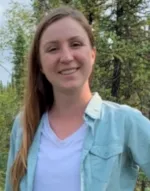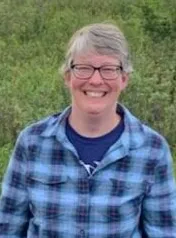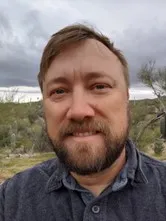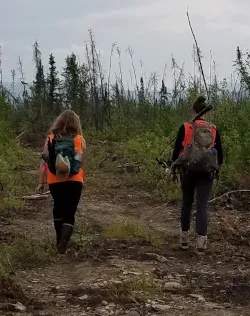CyVerse's Compute Power Accelerates Doctoral Researcher's Science
Doctoral candidate Shelby Weiss harnessed CyVerse's compute power to accelerate the completion of her degree.

Alaskan landscape (Credit: Melissa Lucash)

Shelby Weiss
In late 2021, Shelby Weiss, a doctoral candidate in the Department of Geography at the University of Oregon working on her dissertation on reburn activity in interior Alaska, encountered an unexpected hurdle. She found that the extensive number of simulations needed for her research required extraordinary computing time and resources, far more than her laptop or lab computer could handle. That's when she turned to CyVerse for help. A year and a half later, Shelby has her doctoral degree and has started a new postdoctoral appointment. She gives partial credit to CyVerse, without which she is unsure if she would have finished her simulations in time to graduate.

Melissa Lucash (Credit: Lucash Lab)
Shelby's dissertation research was part of a larger NSF project called Alaska Reburns, led by her doctoral advisor, Melissa Lucash, Research Assistant Professor of Geography at the University of Oregon. Alaska Reburns is a $1.4-million, five-year project that was funded in 2017. The multi-institution collaborative research project also involves the University of Alaska-Fairbanks, the University of Florida, the University of Idaho, the University of Colorado-Denver, the Colorado School of Mines, and North Carolina University. Devised as an attempt to bring the LANDIS-II forest landscape model to interior Alaska, the project is focused on areas of high-frequency fire in interior Alaska and the impacts of these reburns in light of climate change.
The project involves several components, including a vegetative fieldwork piece, led by the University of Colorado-Denver, a soil fieldwork layer led by the University of Florida, and a modeling component focused on questions around wildfire and climate change that was the focus of Weiss' research.
Lucash explained, "This work is centered around having a better understanding of reburns, or short interval fires, where there are two fires that overlap each other but there's a short interval between them. Historically, there would be 100 years between fires. With climate change and warming temperatures, fires are taking place closer to 15 years apart. With these shorter intervals between fires, we wanted to understand what the vegetation and soil look like after each burn."
CyVerse's Compute Power Provides Turning Point

Tyson L. Swetnam
Weiss ran into computing time limitations due to the extensive number of simulations and replicates needed for the project. She and her team realized that additional computing resources were needed to scale her analyses. Through a fellow Lucash lab member, James Lamping, Weiss learned about CyVerse. Lamping had participated in a past CyVerse-NEON data science workshop with Tyson L. Swetnam, Co-PI of CyVerse.
Weiss recalled, "We knew that to run the number of replicates and simulations we needed it would take a lot of computing power. For all the options we explored, it would require creating a Docker container. That's where it was great to work with Tyson, because he had lots of examples to follow and was able to get me started on the right track in terms of translating LANDIS-II to Docker. Eventually, I was able to build an application within CyVerse to run LANDIS-II."

Shelby giving her PhD dissertation (Credit: Melissa Lucash)
Weiss' dissertation involved running 30 simulations in three scenarios, including a historic climate scenario and two different climate change scenarios. Weiss said, "All those replicate simulations were run on CyVerse [Discovery Environment]. Normally that would take a lot of processing power on a local machine, but CyVerse allowed me to have that running in the cloud, so it really freed up resources to do other things locally. It was super helpful in terms of freeing up resources and allowing me to run more replicates at a time than I could have otherwise."
Weiss began working with Tyson in late 2021. "It was a matter of being able to move forward," Weiss recalled. "The challenge of modeling is you're responsible for generating data. The model is the data, and if you don't have model simulations, you don't have data to analyze. So just having more replicates to work with makes a big difference in moving forward with analysis. Once I was able to work with Tyson and CyVerse, the simulations were done within a couple weeks."
"Shelby was most of the way there on the containerization of her LANDIS-II software," Swetnam said. "I was able to help her get the last few packages installed into the new Linux environment doing paired-programming sessions over Zoom." After Weiss' Docker image was created, Swetnam helped her get the image integrated into CyVerse's Discovery Environment, where he maximized the available computing resources (up to 40 cores and 256 gigabytes RAM per analysis) for LANDIS-II to run its largest models.
Lucash added, "I consider the involvement of CyVerse as the game changer. We're continually reminded of how big Alaska is, and it took a long time to run just one simulation. With also trying to do different climate change scenarios, it was becoming impossible to complete her dissertation on time. Shelby tried several different tools and options, but CyVerse was the turning point where she was able to work with Tyson to get it running. I'm not sure what we would have done otherwise. Shelby might not be Dr. Weiss today if it wasn't for CyVerse. Or at least she would have a much more simplistic product."
Training and Support
Weiss noted, "One reason working with CyVerse was great was because I felt like I had resources in terms of Tyson's time. We set up Zoom sessions and he would walk me through it. The big thing was building the Docker container and getting that working. I don't have a computer science background, so I'm grateful to Tyson for pointing me to examples that exist in the CyVerse [code] repository and providing individualized instruction in my case. That made the difference. We tried other options, but the support with CyVerse was stellar and helped me learn things that would have taken much longer to figure out on my own."

Lab members walking through burned vegetation (Credit: Melissa Lucash)
Going forward, Weiss will be working as a postdoc at the National Great Rivers Research and Education Center in East Alton, Illinois, where she'll be doing research on flooding impacts in the upper Mississippi River Basin. Lucash now has funding working with the Bonanza Creek Long-Term Ecological Research Program through the University of Alaska-Fairbanks in interior Alaska. One of the new students in her lab, Gabriel Abreu-Vigil, is planning to pick up his work and take it to the next step, working on the vegetation and hydrology interactions from the Alaska Reburns project.
Lucash said, "As part of Shelby's dissertation, we noticed some things we want to change. Gabriel will run some new simulations and hopefully we can use CyVerse again. I have another project with the University of Colorado-Denver that's funded by NSF with another PhD student, James Lamping, working on that project in Alaska and British Columbia, and he's hoping to use CyVerse for that project as well."
Weiss summarized, "I learned a lot through this experience and benefited by going through the process of building a Docker container. That's something I can take forward and use in the future. I'm grateful to have learned so much by using CyVerse and working with Tyson. I feel capable of taking on projects that use these kinds of resources in the future and to dive right in."

